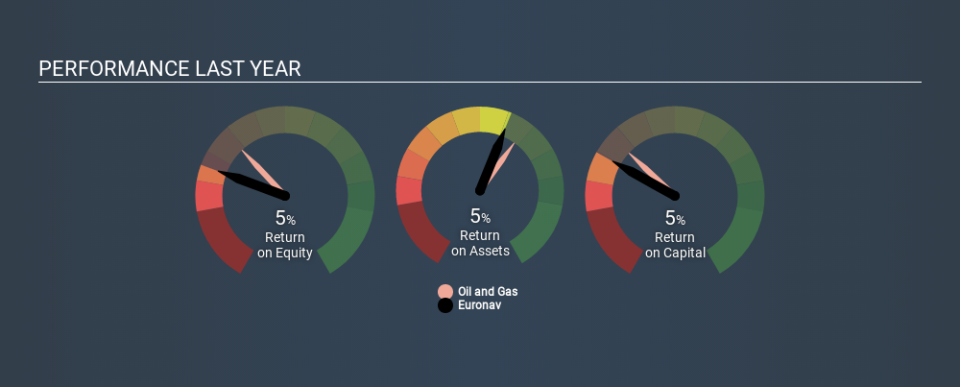Why Euronav NV’s (EBR:EURN) Return On Capital Employed Might Be A Concern

Today we'll evaluate Euronav NV (EBR:EURN) to determine whether it could have potential as an investment idea. In particular, we'll consider its Return On Capital Employed (ROCE), as that can give us insight into how profitably the company is able to employ capital in its business.
First, we'll go over how we calculate ROCE. Then we'll compare its ROCE to similar companies. And finally, we'll look at how its current liabilities are impacting its ROCE.
Understanding Return On Capital Employed (ROCE)
ROCE is a metric for evaluating how much pre-tax income (in percentage terms) a company earns on the capital invested in its business. All else being equal, a better business will have a higher ROCE. In brief, it is a useful tool, but it is not without drawbacks. Renowned investment researcher Michael Mauboussin has suggested that a high ROCE can indicate that 'one dollar invested in the company generates value of more than one dollar'.
How Do You Calculate Return On Capital Employed?
Analysts use this formula to calculate return on capital employed:
Return on Capital Employed = Earnings Before Interest and Tax (EBIT) ÷ (Total Assets - Current Liabilities)
Or for Euronav:
0.047 = US$181m ÷ (US$4.2b - US$316m) (Based on the trailing twelve months to December 2019.)
Therefore, Euronav has an ROCE of 4.7%.
Check out our latest analysis for Euronav
Is Euronav's ROCE Good?
One way to assess ROCE is to compare similar companies. We can see Euronav's ROCE is meaningfully below the Oil and Gas industry average of 8.0%. This could be seen as a negative, as it suggests some competitors may be employing their capital more efficiently. Aside from the industry comparison, Euronav's ROCE is mediocre in absolute terms, considering the risk of investing in stocks versus the safety of a bank account. It is possible that there are more rewarding investments out there.
We can see that, Euronav currently has an ROCE of 4.7%, less than the 6.4% it reported 3 years ago. So investors might consider if it has had issues recently. You can click on the image below to see (in greater detail) how Euronav's past growth compares to other companies.
When considering this metric, keep in mind that it is backwards looking, and not necessarily predictive. ROCE can be deceptive for cyclical businesses, as returns can look incredible in boom times, and terribly low in downturns. This is because ROCE only looks at one year, instead of considering returns across a whole cycle. Given the industry it operates in, Euronav could be considered cyclical. What happens in the future is pretty important for investors, so we have prepared a free report on analyst forecasts for Euronav.
Euronav's Current Liabilities And Their Impact On Its ROCE
Liabilities, such as supplier bills and bank overdrafts, are referred to as current liabilities if they need to be paid within 12 months. Due to the way the ROCE equation works, having large bills due in the near term can make it look as though a company has less capital employed, and thus a higher ROCE than usual. To counteract this, we check if a company has high current liabilities, relative to its total assets.
Euronav has current liabilities of US$316m and total assets of US$4.2b. As a result, its current liabilities are equal to approximately 7.6% of its total assets. Euronav reports few current liabilities, which have a negligible impact on its unremarkable ROCE.
Our Take On Euronav's ROCE
If performance improves, then Euronav may be an OK investment, especially at the right valuation. Of course, you might also be able to find a better stock than Euronav. So you may wish to see this free collection of other companies that have grown earnings strongly.
I will like Euronav better if I see some big insider buys. While we wait, check out this free list of growing companies with considerable, recent, insider buying.
If you spot an error that warrants correction, please contact the editor at editorial-team@simplywallst.com. This article by Simply Wall St is general in nature. It does not constitute a recommendation to buy or sell any stock, and does not take account of your objectives, or your financial situation. Simply Wall St has no position in the stocks mentioned.
We aim to bring you long-term focused research analysis driven by fundamental data. Note that our analysis may not factor in the latest price-sensitive company announcements or qualitative material. Thank you for reading.

 Yahoo Finance
Yahoo Finance 
